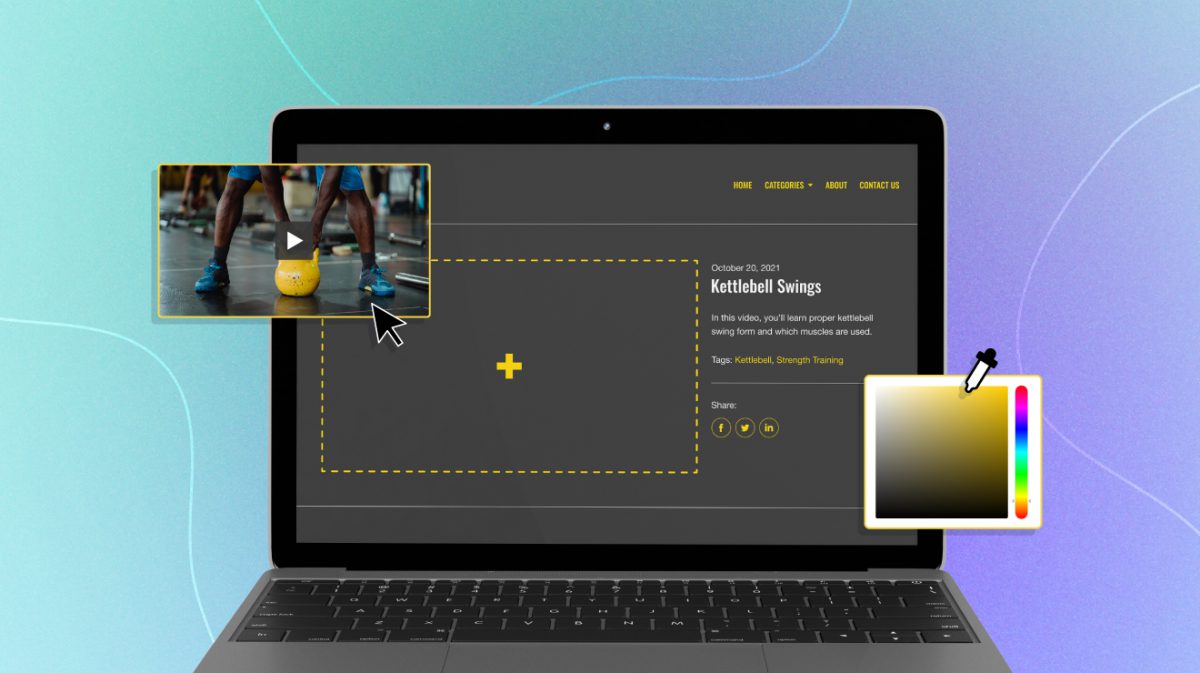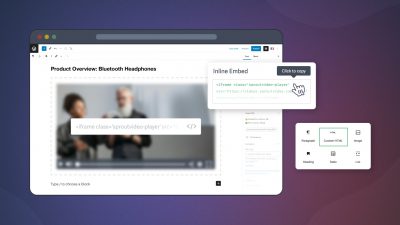Hosted video websites are designed to showcase video front and center. They are an ideal solution for companies and creators who need a destination for viewers.
Whether you want to build an employees-only video library or protect your content behind a paywall, video websites offer an affordable and effective solution.
This article covers making a video website from ideation to launch. With the right platform, you can complete your video website in less than an hour. Let’s begin!
Why Businesses Create Video Websites
Video hosting services with video websites, like SproutVideo, combine all the tools of a video host, website builder, marketing suite, and analytics software in one platform.
Businesses and organizations utilize video websites internally and externally across industries. Use cases include:
- Video Portfolios
- E-learning Platforms
- Membership websites
- Learning and development portals
- Corporate communications
- TV, movie, and ad screenings
Video websites make it easy to create a branded portal for any of your video needs.
How to Create a Video Website
Create a Professional Video Website in 10 Steps
1. Determine the Purpose & Goal
There is a wide range of use cases for video websites. From a videographer who needs a professional portfolio to a non-profit organization that requires single sign-on (SSO), video websites offer a flexible array of purposes and potential goals.
Before selecting a platform or browsing its themes, refine the purpose of your video website and create at least one major goal. For example:
- A video-based knowledge center with the goal of reducing support tickets by 40%
- Employee onboarding that removes managers from the process and incurs a 95% completion rate with new hires
- A members-only video library for paid subscribers that increases retention by 20%
Determine how you will use the video website, what features you need to market the videos or restrict access, and your desired return on investment.
2. Choose a Video Hosting Platform
The video hosting service you choose for your business will depend on what features you need for your website. A video website service should include:
- Website builder: Customize your site design to better showcase your video content.
- Hosting: Upload multiple videos directly to your website.
- Security: Ensure only those with permission are able to access your content.
- Marketing: Require lead capture to view video or direct visitors with in-player CTAs.
- Monetization: Easily integrate payment buttons with third-party applications.
- Analytics: Get real-time data on who is watching and what they’re re-watching.
SproutVideo offers these features (website included) for $35 a month.
Note: Our features provide the ability to secure or market your video content anywhere. If you already have a website, you can embed the video content you’ve uploaded while keeping it private. You can even monetize that video content or create a subscription membership.
3. Select a Theme & Customize
Who doesn’t love aesthetics? Built-in templates make creating a modern video website for your brand easy. Choose the best theme for your goals, then make it shine with customization options.
Add your logo, favicon, and brand colors for easy setup. You have the option to create two pages, such as an About or Contact page. You can use these pages to promote any part of your business.
For limitless possibilities, employ custom CSS or Javascript for advanced customization.
4. Upload Video Content
Determine what video content you will upload to your website. Choose content that aligns with your video website’s purpose and goal. Some questions you might consider include:
- Who is this website for? Who is my target audience?
- What information are they hoping to acquire?
- How can I organize my content for the user’s experience?
As you upload video content, consider the categories you want to feature on your website. These categories should help visitors easily navigate your various video topics, series, or courses.
Finally, use bulk uploading to upload all of your videos at once. Simply add your video files to the queue; each file will upload until all the videos are ready to play. Videos can be uploaded from your computer or an input source, such as Dropbox or Google Drive. You can also upload videos with the SproutVideo API or by setting up automation in Zapier.
5. Optimize for SEO
Search Engine Optimization (SEO) allows visitors to organically find your website when searching. Optimization requires positioning your content to fit the way people are looking for it. You can reduce keyword competition by using more specific search queries.
When doing research, notice that the search engine offers queries (known as long-tail keywords) under “People also ask.” These are examples of highly specific keywords that can be used to more easily rank in search and build website authority.
To optimize video metadata for search engines, include keywords in the title, description, and URL. You can easily do this within settings for any uploaded video.
Your video website’s backend affects SEO as well. SproutVideo optimizes your website by automatically updating the video sitemap and including JSON-LD structured data for newly uploaded videos. Put simply, we ensure search engines can easily find your content.
For more information on optimizing videos for SEO, read our guide on video metadata and review these 17 video SEO best practices.
Note: Never underestimate the importance of video thumbnails. While the title informs both Google and the viewer what your video is about, the thumbnail helps the video stand out among the competition. A great thumbnail can improve ranking if it encourages people to click.
6. Secure Video Content
There are multiple reasons to secure some or all of your video content. Depending on the purpose of your video website, you might need to prevent those who haven’t paid or those who don’t work within your organization from accessing the content.
You can restrict access to your videos with login protection, password protection, or single sign-on (SSO). Login and password protection can be used to restrict access to the entire video website or individual videos. This allows you to set up customized access depending on team roles or subscription tiers.
There are also additional security measures you can take, such as IP address or domain restriction and dynamic watermarking. When setting up the privacy of your videos, use our article on secure video sharing to walk through each step and ensure it’s done correctly.
7. Utilize Marketing Features
If your website will be public facing, there are various tools you can use to market your video content. These include:
- Lead capture: Require viewers to submit their contact information to watch a video.
- In-player CTA: Display a link or text during on-demand videos and live streams.
- Post-play screen: Feature a link, text, or email list sign-up form as the video concludes.
- Email embed codes: Add a video thumbnail that links to a landing page in an email.
- Third-party integration: Connect your video website host and email marketing platform.
Depending on the goal of your video website, determine what tools you will use and create a marketing plan.
If your video website is built for internal or private purposes, you might use the in-player CTA to link other relevant videos or documentation. Additionally, email embed codes can be used for secure internal email communication.
Example: You add a post-play screen to your best-performing video. The post-play screen offers a valuable freebie to viewers in exchange for their email address. Using Zapier, you employ automatic delivery of that freebie by connecting to your email marketing provider. You decide to take this one step further with a welcoming campaign, which triggers when the freebie email is opened. Now you have a marketing funnel!
8. Test Mobile Video Website
Once you’ve finished setting up your video website, test it out on different types of devices. Employ friends and family if necessary to get a variety of perspectives.
At a minimum, view your video website on a smartphone and tablet.
Step into the mindset of someone accessing your website for the first time. Navigate through categories, play a video, and visit pages.
Take note of any changes you want to make as you explore, then update and test your video website again.
Note: All video website themes on the SproutVideo platform are responsive and mobile-friendly.
9. Add a Custom Domain
This step is optional. Your hosted video website account will include a domain name associated with the video host.
However, most businesses and organizations prefer to use a custom domain name from their website hosting provider. For detailed information on how to do this, read our help article.
10. Get Feedback & Launch!
The last step before launch is one of the most important. Get feedback on your video website before launch. The best feedback you can receive is from those who will use the video website.
Ask your audience or employees to be beta testers. Create a Google Form or other survey and get anonymous feedback on the design, navigation, security, and content.
Consider offering a gift card or other reward for completing the survey. This will provide more high-quality feedback.
Once you’ve considered all perspectives and made any changes, you’re ready to share. Debut your video website and celebrate its launch!
How to Monetize Your Video Website
Sell access to your video website from anywhere. This step can be implemented anytime during setup or after launch.
First, determine where you will sell access. This could be a website or landing page, social media, an email campaign, or a combination of these. Anywhere you can share a link or embed a button, you can sell access to your video website.
You will also need login protection through the video hosting platform you chose for your video website. When someone purchases your video, you can automatically send them an email that includes a link to the video and their login information.
Login-protected videos don’t appear on your video website if someone isn’t logged in. You can set viewer logins to expire after a certain period of time or number of uses. You also have the ability to allow downloads of the video (this is disabled by default).
Additionally, we recommend allowing viewers to manage their own password, which is automatically enabled. This reduces support overhead, as users can change their own passwords should they forget.
For complete setup instructions, read our help article on video website monetization.
Whether for internal communication or as a marketing tool in your business, a video website makes it easy to create the best possible experience for viewers while staying on budget. If you have questions about how to set up a video website, we are happy to help!








